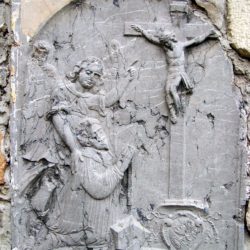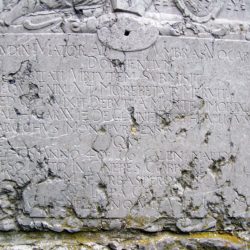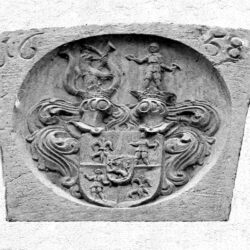
Coat of arms of the Witzenstein family in Mengeš
MENGEš, ST. MICHAEL'S CHURCH
Location of the coat of arms: tombstone
In Mengeš, several tombstone plaques are built into the walls around St. Michael’s parish church, including that of Balthasar von Witz (1609–1650), a priest, protonotary apostolic, and parish priest in Mengeš. His ancestors most probably came to Carniola from German lands. They are first documented in Ljubljana in the second half of the sixteenth century, when the tailor Georg Witz was admitted among the town dwellers in 1570. The family, still Protestant at that time as were the majority of the townspeople, subsequently converted to Catholicism to avoid being expelled from Carniola. Its further destiny was profoundly shaped by Marcus, Georg Witz’s oldest son, born about 1569. At the end of the century, he inherited his father’s winery at Križevniška ulica 12 and soon also ventured into trade (most probably in wine and wheat), which amassed him a great fortune. In 1608, he purchased a meadow, a mill, and a farm on the Glinščica Creek near Ljubljana (the area of modern Vič district) and built a mansion named Glince (Gleinitz). In 1630, he expanded the property on Križevniška ulica by purchasing the house at no. 9 (now 7).
Being a wealthy and eminent town dweller earned Marcus a seat on the internal town council, the office of senior treasurer as well as being elected to several terms as town judge and mayor. However, he did not always lead a morally impeccable life, as his shady financial dealings frequently led him into disputes with the town council and individual town dwellers. One of the pivotal moments in his life came in 1630, when he was raised to the rank of nobility with the predicate containing the name of his mansion at Glince. On that occasion, he was also granted an improvement to his coat of arms, suggesting that he already used it before that. The presentation of the grounds for his ennoblement sheds light on an interesting detail from Marcus’s past—his ten-year active military service in the war against the Turks in Hungary, Croatian territories, and the Maritime Frontier (Germ. Meergrenze). Marcus’s turbulent life was extraordinarily long for the seventeenth century. He died in 1654, at the age of over eighty.
Marcus von Witz had several children, including three sons that reached adulthood. One of them was Balthasar, who became a priest. The other two, Karl and Johann Andreas, were employed by the Carniolan mining court. Both were granted a high noble title with the predicate Witzenstein, which gradually replaced the original family name Witz, and an improvement to the family coat of arms. Balthasar was excluded from further ennoblements and retained the original coat of arms from 1630, which is also depicted on his tombstone plaque in Mengeš.



